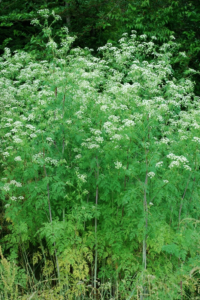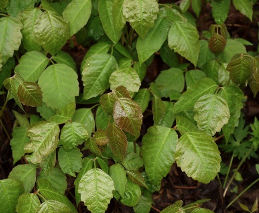Now that the summer season is fully upon us and many children are out of school, families are spending more time enjoying outdoor activities. While summer is a wonderful time for young ones to explore nature, it is also important to understand the dangers the outdoors can hold. Listed below are several poisonous plants to be aware of so you can help your family stay safe outside this summer.
Giant Hogweed
- A large plant that can grow up to 15-20 feet.
- Contains a sap that makes skin very sensitive to UV radiation.
- Exposure to the sap may lead to blistering and burns to the skin, following sun exposure.
- Avoid contact with this plant.
- If you do come in contact with the plant, wash the area immediately and thoroughly with soap and water.

Poison Hemlock
- Should not be eaten; is toxic to humans and animals.
- Part of the carrot family and sometimes mistaken for other plants in this same family including wild carrot, anise, chervil and fennel.
- Side effects of ingesting the plant can initially include vomiting, confusion, decreased breathing and muscle paralysis; death from the plant is usually rapid and because of respiratory paralysis.
- If you find poison hemlock in your yard, remove it quickly to prevent further spread.
- Wear gloves, avoid contact with skin and eyes, and pull up the entire plant, including the root.
- Additional information on removal may be found through the USDA.

Jimson Weed
- Produces strong hallucinogenic effects when swallowed and is sometimes misused by teens.
- Ingestion can include brewing parts of the plant in tea or chewing seed pods, often known as “pods” or “thorn apples.”
- Some side effects include fast heartbeat, hallucination, dry mouth, big pupils, blurred vision and muscle weakness.
- In severe cases, ingestion of the plant has been associated with coma and seizures.

Poison Ivy and Poison Sumac


- Poison ivy has shiny leaves that have 3 leaflets. It grows in a vine but it can also look like a shrub.
- Poison sumac grows mostly in swamps and other wet areas. It is a deciduous large shrub with reddish color stems that turn brownish-grey as the plant ages. The leaves turn red in autumn and drop off.
- Both poison ivy and poison sumac release an oil called urushiol. This oil can cause severe itching, blistering and swelling when it comes in contact with the skin of people who are sensitive to the plant. Do not burn poison ivy or poison sumac as that may cause respiratory symptoms in some people.
- Allergic reactions to poison sumac can be worse than to poison ivy.
- If you come in contact with poison ivy or poison sumac, wash your skin with soap and water including under the fingernails. Wash all clothing or other items that came in contact with the oil form the plant.
- To prevent exposure, cover areas of your skin as much as possible when hiking or walking through wooded areas.
Plants are difficult to identify and often one plant that is non-toxic looks very similar to another plant that is toxic. Some plants can cause toxicity if they are swallowed, and other plants can cause symptoms by touching them.
It is best to never eat or touch an unidentified plant unless an expert confirms that it is safe to do so.
There are some plant identification apps that are available for use on smartphones. These apps are becoming more available. Accuracy can vary with apps, so it is recommended to use them with caution and to always call your Poison Control Center at 1-800-222-1222 if you or someone you know has been exposed to a plant.





